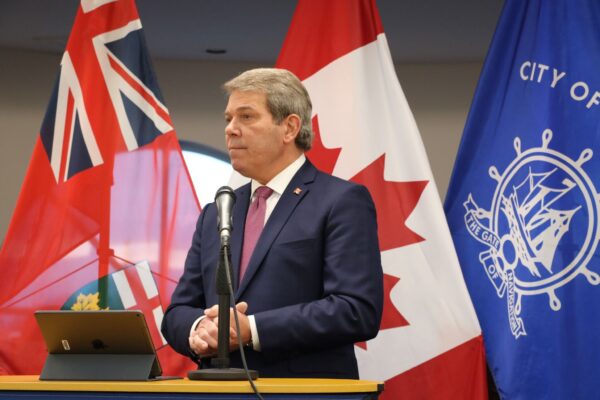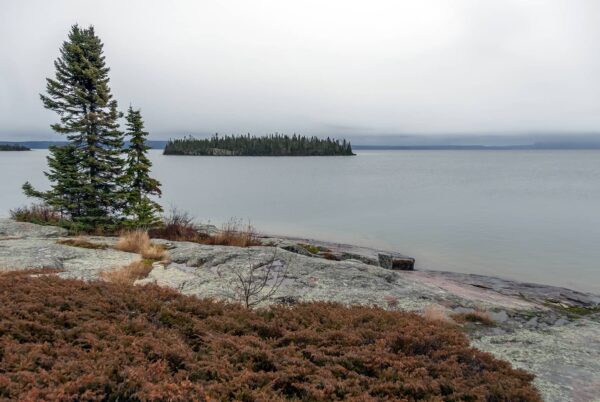What common themes exist across the Great Lakes region around climate action? What if the region had a unified vision? A team from the University of Michigan School for Environment and Sustainability (SEAS) and the Erb Institute for Global Sustainable Enterprise aimed to find out.
With the passage of the Inflation Reduction Act (IRA) in 2022—legislation often touted as the most significant investment in climate action and clean energy in American history—the U.S. Environmental Protection Agency (EPA) created the $5 billion Climate Pollution Reduction Grants program, offering unprecedented levels of federal funding for climate planning and implementation.
In the first phase of the program, the EPA distributed $250 million in planning grants to states, cities, Metropolitan Statistical Areas (MSAs), Tribes and U.S. Territories for the development of a Priority Climate Action Plan. The plans outlined each jurisdiction’s greenhouse gas emissions reduction strategies, and were due in spring 2024. The EPA received submissions from 45 states, 82 cities and MSAs, 81 Tribes and Tribal consortia, and four territories. For many jurisdictions, this was their first-ever climate planning effort. In phase two, jurisdictions will submit a Comprehensive Climate Action Plan to the EPA by mid-2025.
Liesl Clark, inaugural Director of Climate Action at SEAS and former director of the Michigan Department of Environment, Great Lakes and Energy (EGLE), saw a unique opportunity to do a deeper dive into the Great Lakes region’s plans. She hoped to uncover key trends, best practices, and potential areas for collaboration across state and jurisdictional lines.
Clark assembled a team, in close coordination with partners from the Erb Institute for Global Sustainable Enterprise, and launched an ambitious eight-week project with this central goal in mind. “Given that we sit in the heart of the Great Lakes and 21% of the world’s fresh surface water, we wanted to explore the region’s plans to identify the highest-impact, most innovative and scalable multi-state opportunities. We looked for what was working, to inform ways to accelerate community-based climate action,” Clark said. The culmination of Clark’s team’s work, a summary entitled, “Life is Better By the Lakes: How the Great Lakes Region is Responding to EPA Calls for Action in Climate Leadership”, was released on Thursday, May 16, 2024.
Clark is no stranger to efforts like this, having chaired the Michigan Council on Climate Solutions, which advised EGLE preparation of the MI Healthy Climate Plan and positioned Michigan as a leader in decarbonization initiatives among U.S. states.
The team, led by Clark and composed of U-M Deputy Director of Communications and Engagement for the SEAS Sustainability Clinic, Lauren White (MS ’15), and three dual-degree graduate students—Victoria Jenkins (MBA/MS ’24), Mahima Obhrai (MBA/MS ’25) and Jaya Uppal (MBA/MS ’26)—began its work in mid-March. Jenkins, Obhrai and Uppal are completing MBAs at the Ross School of Business and MS degrees at SEAS.

The students read and analyzed plans from six Great Lakes states—Wisconsin, Minnesota, Indiana, Illinois, Ohio and Michigan—as well as tribal plans from the Forest County Potawatomi, Midwest Tribal Energy Resources Association and Keweenaw Bay Indian Community. The team also selected plans from key cities and MSAs in the region: Chicago, Detroit, Milwaukee, Cleveland, Indianapolis, Columbus and West Michigan/Grand Rapids.
The team evaluated each plan for metrics such as climate targets (e.g. carbon neutrality by 2050), benefits and drawbacks of the plan’s proposed measures on Low-Income/Disadvantaged Communities (LIDAC) and funding models. The team also examined existing greenhouse gas inventories, resiliency plans and current transition efforts underway. Finally, the team summarized findings by sector, highlighting any particularly strong proposed solutions or, conversely, areas of opportunity—specifically relating to transportation, power and the built environment.
All told, the team read a whopping 2,155 pages!
“Our original intention was to do an apples-to-apples comparison, as much as possible,” said Clark. “But we discovered that the quick turnaround from the EPA required the responders to focus their plans on climate measures that would play a prominent role in their applications for competitive funding. Still, there is value in reviewing these plans to get an understanding of priority actions steps, to find overlap and to identify gaps.”
There were several key takeaways from the project. First, the team emphasized that climate action and decarbonization work is most effective if done in a collaborative, informed way in partnership with communities. Many of the proposed initiatives were highly dependent on public engagement, trust and broad community buy-in. In some places, pushback against renewables and general distrust of new technologies can be a barrier; in others, historic disinvestment and a high energy burden warrants deep listening and repair, first and foremost, before embarking on any new efforts. The team also found opportunities for jurisdictions to stack multiple federal incentive programs and financial resources, helping defray the high startup costs of many measures proposed in the plans.
Unsurprisingly, the team observed that collaboration across boundaries would help accelerate decarbonization in the Great Lakes region, enabling the sharing of best practices and lessons learned. This work can be siloed, but collaboration provides a chance to form a more holistic vision and to position the Great Lakes as a leader in climate action across the U.S.
Another central finding was the need to expand workforce development, to better equip a just energy transition. Whether heightening opportunities for training in renewable energy, creating sustainability literacy through educational programs and outreach, or offering skill-building in finance and markets, having an expert workforce at the ready will be critical—particularly interdisciplinarily trained talent. Ensuring that these new job opportunities are equitably distributed and accessible to all was another important takeaway.
Clark sees a pathway for further research on the climate plans, which may include an expansion of geography, a more encompassing look at the measures, or use of large language models to synthesize themes.
From Uppal’s perspective, future research could involve a deeper dive into LIDAC and workforce planning. “While LIDAC and workforce benefits are mentioned in the measures of many plans, they are largely not specific or quantifiable. If the EPA could set more defined guidelines around what exemplary LIDAC and workforce plans look like for the future plans, it could help states and other jurisdictions to be more responsive.”
Jenkins was keen to see the plans deployed in communities, as a means of generating more support for climate action. “A key opportunity I see for jurisdictions to hone in on in future reporting is harnessing the incredible measures and targets included in the plans into a cohesive, compelling narrative with their local communities,” she said. “Storytelling is vitally important when securing buy-in and support for climate action, and being able to communicate the tangible, every-day benefits of these proposed measures to citizens will be inherent in implementing these emissions reduction measures in practice.”
The students on the team were impressed by the creativity and leadership demonstrated by each jurisdiction. “From my perspective, Michigan and Illinois are role models for other states to look to as they develop decarbonization strategies,” said Uppal. “They have taken the lead in creating specific, measurable goals [and] already had existing climate targets in the MI Healthy Climate Plan in Michigan, and through the Climate and Equitable Jobs Act in Illinois. Both states used their responses to further build on these plans, and tackle decarbonization in sectors they previously didn’t have the resources to focus on.”
Clark hopes that this work will continue, given the amount of information and data that states, cities and Tribes are putting into their responses and the opportunity that creates. “The themes found in this round of research—collaboration, workforce development, public engagement and stacking financial resources—are essential for advancing climate action. Further examination will enhance our understanding of current policy frameworks and help identify what levers may exist, to make implementation less costly and more effective,” she said.
“It’s heartening to see the wealth and range of thoughtful, visionary ideas proposed,” added Obhrai. “These are challenging times we live in, and climate anxiety can sometimes threaten to overtake even the most doggedly optimistic among us. The plans give me hope for a more climate-resilient future for the Great Lakes.”
This article was originally published on the University of Michigan School for Environment and Sustainability’s (SEAS) website and is republished here with permission.
AUTHORS:
Liesl Clark, Director of Climate Action Engagement, University of Michigan School for Environment and Sustainability (SEAS)
Lauren White, Deputy Director of Communications and Engagement, SEAS Sustainability Clinic
CGLR’s business and sustainability network programming is supported by the Fred A. and Barbara M. Erb Family Foundation.




